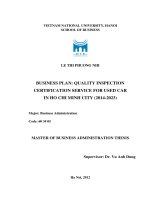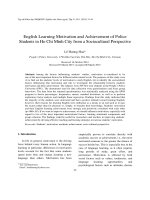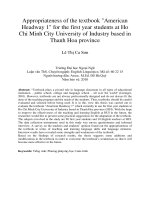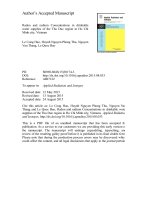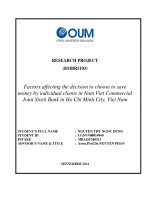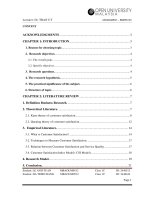Customer satisfaction and service quality in the banking industry (agribank) in ho chi minh city
Bạn đang xem bản rút gọn của tài liệu. Xem và tải ngay bản đầy đủ của tài liệu tại đây (958.87 KB, 131 trang )
CUSTOMER SATISFACTION AND SERVICE QUALITY IN THE BANKING
INDUSTRY(AGRIBANK) IN HO CHI MINH
________________________
A dissertation presented to
The Faculty of Graduate School
Tarlac State University
Tarlac City
___________________________
In Partial Fulfillment
of the Requirements for the Degree
Doctor of Philosophy
Major in Business Administration
VU MINH HIEU
March 2013
Republic of the Philippines
TARLAC STATE UNIVERSITY
GRADUATE SCHOOL
Tarlac City
APPROVAL SHEET
This Dissertation of VU MINH HIEU entitled “Customer satisfaction and
service quality in the banking industry (Agribank) in Ho Chi Minh City” which
is prepared and submitted in partial fulfillment of the requirements for the Degree of
Doctor of Philosophy, Major in Business Administration, is hereby accepted.
Charles H. Cransford. PhD
Dissertation Adviser
DISSERTATION COMMITTEE
____________________
Chair man
____________________
Member
____________________
Member
____________________
Member
____________________
Member
Accepted and approved in partial fulfillment of the requirements for the
Degree of Doctor of Philosophy, Major in Business Administration.
____________________
Dean, Graduate School
Date: ____________________
i
© 2013
Vu Minh Hieu
ALL RIGHTS REVERVED
ii
ABSTRACT
Title:
CUSTOMER SATISFACTION AND SERVICE QUALITY IN THE
BANKING INDUSTRY (AGRIBANK) IN HO CHI MINH CITY.
Researcher:
VU MINH HIEU
Institution:
Tarlac State University
Tarlac City
Course:
Doctor of Philosophy
Major:
Business Administration
This study aims at identifying factors influencing to the level of customer satisfaction
with the quality of Vietnam Bank for Agriculture and Rural Development
(Hereinafter is abbreviated by Agribank).
The data is collected from 142 corporate customers of Agribank in Ho Chi Minh City,
focusing on the corporate customer. This study examined determinants of customer
satisfaction of Agribank in Ho Chi Minh City, build up the research model to measure
customer satisfaction based factors influencing to them, examine the customer
satisfaction level to bank products and also recommend the customer satisfaction
improvement to Agribank Ho Chi Minh City.
This research uses the quantitative and qualitative research method through the
evaluation with Exploratory Factor Analysis (EFA) and the reliability test by
Cronbach's Alpha, then the regression analysis which is used to test the research
model.
The proposed model identifies the service quality to improve, with the aim of offering
Agribank services characterized by higher quality level.
iii
ACKNOWLEDGEMENTS
The completion of my doctoral research would not be possible without the immense
contributions of a number of people: friends, colleagues and students, relatives and all
family members, especially for my parents who are always encouraging and
motivating me to finish this dissertation. I would like to express my thank you to all.
I particularly wish to express my gratitude to my supervisor Dr Charles H. Cranford
for his supervision - for reviewing the progress of my work and offering valuable
advice that helped me to direct my research and keep it in track.
I sincerely own thanks to Dr Phan Quan Viet and his wife for their provisions of
journals, books… for my reference.
More of that, I also send my great thank you to Mr Nguyen Van Phuc – my Doctoral
classmate who give me many valuable advice to complete this dissertation.
Last but not least, I must express my gratitude to my wife and children for their
enormous support, encouragement and understanding during these years of study.
iv
LIST OF FIGURES
Figure
Page
1
1. Service Quality Model......................................................... 13
2
The Gaps Model……………………………………………...
3
Determinants of Perceived Quality of Service………………. 14
4
Service quality model………………………………………... 16
5
Service Quality and Customer Satisfaction………………….. 26
6
Research Process…………………………………………….. 34
7
Conceptual paradigm of the study……………………………
8
Factors for research model…………………………………...
36
9
The overall research model…………………………………..
58
10
Adjusted research model …………………………………….
69
v
14
LIST OF TABLES
Table
Page
1
The measurement scale on the customer satisfaction factors……. 45
2
Summary of the coded measurement scale………………………
3
Descriptive statistics of customer expectations………………….. 48
4
Descriptive statistics of the service quality scales……………….
49
5
Descriptive statistics of the price competitives scales…………...
50
6
Descriptive statistics of the corporate image scales……………
50
7
Descriptive statistics of customer satisfaction…………………...
51
8
Results of the analysis of Cronbach's coefficient alpha………….
54
9
EFA result………………………………………………………..
57
10
Pearson’ result on factors of customer Satisfaction……………...
60
11
Results of Pearson analysis of Customer Satisfaction…………...
61
12
Results of regression analysis……………………………………
65
13
Summary of the measurement scale of the customer satisfaction.. 73
vi
46
TABLES OF CONTENTS
Approval sheet………………………………………………………...……………….i
Ccopyright page……………………………………………………………………….ii
Abstract………………………………………………………………...…..……...….iii
Acknowledgments……………………………….…………………………………....iv
List of figures……………………………………………………..………………......iv
List of tables…………………………………………………………………………..vi
Chapter
I.
THE PROBLEM AND ITS BACKGROUND ............................................... 3
Statement of the problem .................................................................................. 3
Research objectives........................................................................................... 5
Research questions............................................................................................ 5
Content of the study.......................................................................................... 7
Definition of terms............................................................................................ 8
II.
REVIEW OF RELATED LITERATURE AND STUDIES .......................... 9
Introduction ......................................................................................................9
Related literature and studies, along with conceptual framework....................... 9
Definition of service, quality and service quality. ........................................9
Conceptualization of Service Quality ........................................................ 13
Functional and Technical Service Quality model and the corporate image . 17
Service quality measurement and its instruments....................................... 21
Definition of customer satisfaction and its models and measurements ....... 24
The links between service quality and customer satisfaction...................... 27
The role of price and its relation with customer satisfaction....................... 30
III. METHODS OF STUDY AND SOURCES OF DATA ................................ 35
Introduction .................................................................................................... 35
The research model......................................................................................... 35
Hypotheses ..................................................................................................... 38
The measurement model of the customer satisfaction...................................... 38
The descriptive model ............................................................................... 38
Determinants of the customer satisfaction ................................................. 40
Research methodology.................................................................................... 40
Data collection................................................................................................ 41
Primary data.............................................................................................. 41
Secondary data.......................................................................................... 41
Research design .............................................................................................. 41
Qualitative method.................................................................................... 41
Quantitative research................................................................................. 44
Questionnaire design ................................................................................. 48
IV. ANALYSIS AND FINDINGS OF DATA .................................................... 50
The descriptive statistics ................................................................................. 50
1
Identifying customer needs........................................................................ 50
Factors influencing to the customer satisfaction......................................... 51
Measurement of customer satisfaction....................................................... 52
Analysis of the measurement scales ................................................................ 53
Cronback’s alpha ...................................................................................... 53
Exploratory Factor Analysis (EFA) ........................................................... 56
The generalised research model ...................................................................... 59
The research model ................................................................................... 59
Hypotheses................................................................................................ 59
Testing the research model.............................................................................. 60
Pearson’s correlation coefficient analysis .................................................. 60
Regression analysis ................................................................................... 62
ANOVA analysis ...................................................................................... 67
Findings.......................................................................................................... 68
Identifying customer needs........................................................................ 68
Factors influencing to the customer satisfaction......................................... 69
Measuring the customer satisfaction.......................................................... 73
The links between seniority & number of banks & customer satisfaction... 74
V. SUMMARY OF FINDINGS, CONCLUSIONS AND RECOMMENDATIONS
................................................................................................................ 75
Summary of findings....................................................................................... 75
Conclusion...................................................................................................... 75
Recommendations........................................................................................... 77
Orienting the development strategy ........................................................... 77
Improving the service quality .................................................................... 78
Upgrading the staff professional competence ............................................ 79
Assuring the price competitiveness............................................................ 80
Building a professional working environment ........................................... 81
Developing the cooperation with financial institutions............................... 81
Strengthening the good image in customer concepts.................................. 82
Recommendations to Agribank Head Office.............................................. 82
Implications and Limitations........................................................................... 84
Theoretical implications ............................................................................ 84
Practical implications ................................................................................ 84
Limitations and recommendations for future research ..................................... 85
BIBLIOGRAPHY ................................................................................................. 87
APPENDIX A. Questionnaire to customers ........................................................ 98
APPENDIX C. The second EFA ........................................................................ 106
APPENDIX D. The third EFA........................................................................... 111
APPENDIX E. EFA with measurement of customer satisfaction..................... 116
APPENDIX F. The regression analysis ............................................................. 117
APPENDIX G. ANOVA Analysis ...................................................................... 119
APPENDIX H. The link between seniority and number of banks and customer
satisfaction ........................................................................................... 121
APPENDIX K. Decriptive statistics ................................................................... 121
2
CHAPTER 1
I. THE PROBLEM AND ITS BACKGROUND
Introduction
Customer satisfaction is one of the key issues for companies in their efforts to
improve quality in the market place. Most businesses have their own targets for being
profitable. They have carefully planned and implemented strategies, but they all have
something in common – a customer. Business purposes are based on customers and if
companies want to be successful, they must concentrate on them.
This means determining customers’ needs, responding to their requirements and
maintaining customer satisfaction by assuring quality in business’s operations. More
of that, customer satisfaction is so important because satisfied customers spread
positive word of mouth that attracts more new customers and then companies will sell
more and gain high profits. (Garson 1993, 5.)
Statement of the problem
In Vietnam, with the current rapid globalization and international economic
integration in the region, with the technology development and the Vietnam market
openings, with the banking sector, after nearly four years of joining the World Trade
Organization (WTO), banking system of Vietnam has made marked progress and
positive. Banks are rapidly developing in size, make technological innovation and
improve the quality of human resources in accordance with the integration process.
However,
World
Trade
Organization accession also
poses challenges to
competitiveness, service quality, customer satisfaction, as well as long-term
connection to the customer's bank.
3
In addition, there are great competitions between the State bank, commercial joint
stock banks and foreign invested banks in Vietnam in general and in Ho Chi Minh
City in particular. With that competition, customer satisfaction has become more
important. In the fierce competitive environment, customer is the decisive factor of
the bank existence. Banks with customers’ interests and loyalty will win and grow.
All the business strategy towards customers is becoming the most important.
Coordination with customers in business, attraction to new customers, strengthening
to existing customers are becoming a very effective tool for the business. Therefore,
the most important problem is how banks think about methods to give the best
customer satisfaction with their highest efforts and abilities. In addition, customer
satisfaction will be useful for the creation of customer loyalty, which is necessary to
maintain the operation of the Bank. Besides, during the competition, the creation of
customer loyalty does not to make sure that customers will survive long-term with the
Bank. Hence, banks should pay special concerns to customers. This means that the
responsibility for developing and maintaining relationships with customers, making
customer satisfaction are of the bank. Banks need to be proactive in the maintenance
and development of this relationship.
Not only in Ho Chi Minh City but also in Vietnam, Vietnam Bank for Agriculture
and Rural Development (Agribank) is one of the leading commercial banks with 2200
branches and transaction offices, 98 branches and transaction offices in Ho Chi Minh
City and 8 companies. Like any banks, Agribank still gains the satisfaction of their
customers but they are with different levels by customer needs and feelings. As
known, most of Agribank have same of working styles, conditions, procedures,
decorations, etc. Therefore, the service quality is also same in Agribanks in Ho Chi
Minh City.
4
With the studies’ results of Ruyter et al. (1997), Brady et al. (2001) and
Sureshchandar et al. (2002) indicated that there was a certain relationship between
service quality and customer satisfaction based on different cultural background. In
addition, service quality had significantly impacts on customer satisfaction and they
were highly related.
Therefore, the study of customer satisfaction for the bank is the important work
that must be done regularly and continuously to be able to respond promptly to
changes in their needs so that we can better serve customers and always make the
customer be satisfied when using the bank services and products. The study
"Customer satisfaction and service quality in the banking industry (Agibank) in Ho
Chi Minh City" is done not out of purpose and with a hope to get more comments to
the issue of research to be more completed.
Research objectives
Based on the current situation in the operation and development of the Ho Chi
Minh City Agribank, this study is to answer the following:
Determining the customer expectations to Agribank in Ho Chi Minh City
Building up the research model to measure customer satisfaction based
factors influencing to them
Examining the customer satisfaction level to bank products
Recommending on how to improve the customer satisfaction to Agribank
Ho Chi Minh City.
Research questions
1. What are determinants of customer satisfaction in Agribank Ho Chi Minh City?
5
2. What is the level of customer satisfaction among the Agribank clientele in Ho
Chi Minh City?
3. What is the quality of service among Agribanks in Ho Chi Minh City?
4. Is there a relationship between customer satisfaction and sevice quality?
5. What are the implications of the study to business administration?
Scope and delimitation of the study
The data of this study is focusing on the customer of Agribank, especially for Ho
Chi Minh City branch. Due to the limited resource and time constraints, this study is
focusing on the customer as corporate customers by the following causes::
First, this group of customers can be understood well in their financial potential
Second, because of the huge demand and the regular financial transactions from
corporations, they have regular transactions with the bank. Therefore, the deployment
of services for corporate customers and the feasibility will be high and significant
scale and, at the same time, they also bring more profitable for the bank comes from
the usual frequency services.
Third, as per security requirements in the operation of the bank, Vietnam has the
high country’s risk in comparison with other countries, therefore, the corporate may
be has lower risk potential with retail customers because the bank has deep
understanding in their customers’ financial situation, credit histories and changes in
their operations.
However, it is possible that findings and results will be the guideline not
only for the further research in the other banks and but also for the banking industry.
6
The findings imply that service quality is not the only factors that could lead to
customer satisfaction in service sectors; that service quality dimension varies in the
different service sectors. The findings suggest that to provide quality service in order
to satisfy customers, organizations in this type of service sectors in need of improving
service quality dimensions. In addition, to provide overall satisfaction to customers,
the service sector needs to improve other factors that were given as reasons for
satisfaction. This study contributes to existing theories by confirming or adding value
to relationships that are involved in customer satisfaction, service quality, and
SERVQUAL dimensions. It provides results that could be useful to managers in
business organizations for strategic planning.
Content of the study
The study is organized in five chapters as following:
Chapter 1 is the introductory chapter. It includes the background, problem
statement, purpose of the study, objectives, research questions, importance, and
structure of thesis.
Chapter 2 reviews relevant literature, concepts and theoretical framework as
overall customer satisfaction, factors influencing to customer satisfaction, research
model, etc.
Chapter 3 provides the research methodology. It focuses on the research
perspectives, data collection. It identifies hypotheses and explains in detail the main
constructs and concepts as well as their indicators and measurements.
Chapter 4 presents the data analysis, results and findings and hypotheses and
chapter summary.
Chapter 5 presents the conclusions and implications.
7
Definition of terms
Quality of service - Quality of service is to provide excellent service compared to
the expectations of customers (Zeithaml & Bitner, 1996).
Customer satisfaction - Customer satisfaction is the response of consumers
responding to the expectations (Oliver, 1997).
8
CHAPTER 2
II. REVIEW OF RELATED LITERATURE AND STUDIES
Introduction
The previous chapter introduces an overview of the study background, research
objectives and research questions. This chapter provides a detailed review of relevant
literature, brief concepts, theoretical framework and the research model, etc.
Related literature and studies, along with conceptual framework
Definition of service, quality and service quality.
Service can be defined in many ways depending on which area the term is being
used. An researcher author defines service as “any intangible act or performance that
one party offers to another that does not result in the ownership of anything” (Kotler
& Keller, 2009). Although services contribute almost 80% to the world’s economy,
consensus on the definition of “service” is yet to be reached. “Despite more than 25
years of study, scholars in the field of service management do not agree on what a
service is. Indeed, instead of coming closer to a definition they seem to be less
certain” (Haywood- Farmer and Nollet, 1991).
Services have been defined as intangible and perishable goods, produced and
consumed simultaneously (Sasser et al., 1978), activities or series of activities of more
or less intangible nature provided as solutions to the customer’s problems (Gronroos,
1990), processes, and performances (Zeithaml and Bitner, 1996; Gronroos, 2000),
time-perishable and intangible experiences performed for a customer who acts as a
coproducer, (Fitzsimmons and Fitzsimmons, 2001) etc.
Because of the explosive development of service sectors worldwide service
quality is today considered as a driver to corporate marketing and financial
9
performance (Buttle, 1996), the foundation of services marketing and the basis of
sustainable success and survival in the marketplace (Fitzsimmons and Fitzsimmons,
2001). Service excellence is no more a matter of courteousness or corporate offering
but the most decisive weapon in a firm’s quiver and the concept of service quality has
been subjected to extensive research. However, a definition of service quality is not
straightforward. Service quality is a synthetic term and no such definition can be
attempted before the term’s components are discussed.
Many of these definitions either directly or implicitly refer to the distinct
characteristics of services as compared to physical good. The most important
characteristic of services is that they are “processes consisting of a series of activities
where a number of different types of resources are used, often in direct interactions
with the customer, so that a solution is found to the customer’s problem” (Gronroos,
2000). Most other characteristics are consequences of the process nature of services
(Gronroos, 2001).
While tangible goods are first manufactured and then stored, transported, sold
and used, most services are first sold and then simultaneously produced and
consumed. While customers of tangible goods rarely visit a manufacturing plant,
most services require the physical presence of customers to be simultaneously
produced and consumed (Berry, 1999). Because of the inseparability of production
and consumption, services cannot be subject to a predetermined quality control
process or marketed in the traditional way (Gronroos, 2000).
The essence of service, however, is intangibility (Zeithaml et al., 1990) despite
some services including certain tangible elements. Because of intangibility services
are perceived by customers in subjective and highly abstract ways.
10
The term quality comes from the physical goods literature. To most people
quality is associated to tangible items but not always to services. Defining quality has
always been challenging. Even the quality “gurus”, W. E. Deming and J.M. Juran,
struggled to find the exact words to put in a definition of quality.
Juran offers two definitions of quality (Juran and Godfrey, 1998): "Quality
means those features of products which meet customer needs and thereby provide
customer satisfaction" and "Quality means freedom from deficiencies-freedom from
errors that require doing work over again (rework) or that result in field failures,
customer dissatisfaction, customer claims and so on”. Deming (1986), on the other
hand, goes around a definition of quality, explaining that quality means different
things to different people, depending on the situation. Finally, he suggests that the
customer's definition of quality is the only one that matters.
Quality is also defined as "conformance to requirements” (Crosby, 1979) or as
“... a customer’s determination” (Feigenbaum, 1983). Garvin (1984) defined quality
as a function of eight dimensions: performance, features, reliability, conformance,
durability, serviceability, aesthetics and perceived quality.
The American Society for Quality ( in line with
Feigenbaum (1983), defines quality as “a subjective term for which each person has
his or her own definition” adding that in technical usage, quality can have two
meanings, i.e. “the characteristics of a product or service that bear on its ability to
satisfy stated or implied needs” or “a product or service free of deficiencies”.
International standard ISO 8402(1994) defines quality as “the totality of
characteristics of an entity (product, service, process, activity, system, organization,
person) that bear on its ability to satisfy stated and implied needs”.
11
Upon to the service context, service providers such as financial service
organizations, hospitals, educational institutions etc. define quality in their own
terms.
As a result of the characteristics of services, the principles and practices of
product quality control cannot be used for assessing service quality. Service
intangibility implies that the criteria for a flawless service are not only less specific
than the criteria for a defect-free tangible good (Berry and Parasuraman, 1991) but
also exceptionally composite and not easily identifiable.
From the marketer’s perspective, service quality can be viewed as the level of
service attributes needed to make the service acceptable and profitable in the market
place, thus, satisfying the marketers’ needs for profitability and economic success.
On the other hand customers view service quality as equivalent to the level of service
attributes required to satisfy their own needs and requirements. In this respect
marketers try to define service quality in advance while customers make during and
after use evaluations.
Customers perceive service quality in a subjective (sometimes irrational and
sentimental), way and in clearly human terms (Lewis, 1993) and, because of service
intangibility and impermanence, by referring to their general experience and/or
memories (George and Hazlett, 1997). One thing is clear, unlike products the quality
of services is evaluated by customers not only by the service outcome (core service)
but also by the production and delivery process as well as by the “peripherals’’
related to the service (Zeithaml et al., 1990; Zeithaml and Parasuraman, 2004).
To assess the quality of services, and form an impression about the relative
inferiority/superiority of a service provider and its services (Bitner and Hubert,
12
1994), customers compare the level of the service delivered to them with their own
personal expectations, shaped by past experience (Gronroos, 1982, 1984; Lehtinen
and Lehtinen, 1982; Lewis and Booms, 1983). The result of this comparison is
defined as perceived service quality (Gronroos, 1982, 1984; Takeuchi and Quelch,
1983; Parasuraman et al., 1985, 1988). Perceived service quality has been defined as
the customer’s global attitude or judgement “related but not equivalent to
satisfaction” of the overall excellence or superiority of a service (Parasuraman et al.,
1988).
What counts in services is the conformance to the wishes of customers rather
than to any predetermined set of specifications (Berry et al., 1988). As Lewis and
Booms (1983) put it “service quality is a measure of how well the service level
delivered matches customer expectations. Delivering quality service means
conforming to customer expectations on a consistent basis”. This means that, in the
final analysis, customers are the exclusive judges of service quality no matter what
the marketer thinks. If customers disagree with the marketer’s perspective then the
service is problematic (Berry and Parasuraman, 1991). “There is no other fact or
reality about service quality but what customers perceive about a service” (Lewis,
1993).
Conceptualization of service quality
Initial conceptualizations of service quality (Gronroos, 1982, 1984; Parasuraman
et al., 1985) were based on the disconfirmation paradigm (Oliver, 1980), stemming
from the natural goods quality literature. The disconfirmation paradigm defines service quality as a result of the comparison between perceived and expected service
performance.
13
The European model is based on the work of Christian Gronroos (1982, 1984)
who considers services as products requiring to a large extent the customer’s
involvement in the process of simultaneous production and consumption. Gronroos
(1982, 1984) separates service quality into “technical quality” related to the result of
the service, i.e. “what” the customer gets and “functional quality” reflecting the way
that the service is delivered, i.e. “how” the customer gets the service. He proposes
that customers’ expectations for a service are influenced by such factors as:
traditional marketing activities by the firm (promotion, pricing, availability etc),
external influences (tradition, habits, ideology, political beliefs etc), and word-ofmouth (Gronroos, 1984).
Perceived service quality is influenced by the “technical” and “functional”
quality of the service delivered by the company through “image”, a function of
“technical” and “functional” quality.
Figure 1. Service Quality Model (Source: Grönroos, 1984)
The main criticism addressed to the European model, and perhaps the reason
behind its lack of popularity compared to the American model, is that it does not offer
explanations on how to measure the different aspects of service quality, especially
14
technical quality. As a result, researchers have to develop their own scales each time
they need to measure technical quality (Kang and James, 2004) and different items
have been used in different studies for this purpose. Technical quality is usually
measured using qualitative methods.
The Gaps Analysis Model or simply the Gaps Model was introduced by
Parasuraman et al. (1985, 1988) as a result of a qualitative research project aiming at
the investigation of service providers’ perceptions of service quality, problems and
processes created during the delivery of quality services, customers’ perceptions of
the basic characteristics of quality, differences in quality perceptions between
customers and service providers and the development of a general conceptual model
for service quality that will take into account both the marketers’ and the customers’
viewpoints.
Figure 2. The Gaps Model (Source: Parasuraman et al, 1988)
From the customers’ perspective Parasuraman et al. (1985) defined perceived
service quality as the size and direction of Gap 5 (Figure 3.5.), a function of Gaps 1,
2, 3 and reflecting the discrepancy between expected and perceived service through
15
initially ten and finally five core components (dimensions) of service quality
(Parasura- man et al., 1988). The initial ten dimensions were: reliability (consistent
performance and dependability), responsiveness (willingness/readiness to serve),
competence (possessing knowledge and skills), access (approachability and ease of
contact), courtesy (politeness, consideration and friendliness of staff), communication
(updating and listening to customers), credibility (trustworthy and reputable, with
customer interests at heart), security (freedom from danger and risk), customer
knowledge (understanding needs and personalised attention), as well as tangibles
(facilities and physical features).
As a result of subsequent research these dimensions merged into five broader
categories; Reliability - the firm’s ability to perform the promised service dependably
and accurately, Responsiveness - the firm’s willingness to help customers and
provide prompt service, Assurance - the knowledge and courtesy of employees and
their ability to inspire trust and confidence, Empathy - the caring, individualized
attention the firm provides to its customers and Tangibles - the level of the tangible
elements of service (Parasuraman et al., 1988).
Figure 3. Determinants of Perceived Quality of Service (source: Parasuraman et
al., 1985 and Parasuraman et al., 1988)
The European school criticizes the Gaps Analysis model in that it refers only to
16
functional quality without really referring to technical quality. The Nordic school
followers claim that the Gaps Analysis model offers no explanation about “what”
must be reliable, responsive, assured, empathetic, and tangible. The argument is that
if the perception of overall service quality is a latent variable then it must refer to
something which is not evident in the Gaps Analysis model (Brady and Cronin,
2001). Further, the American model does not offer clear procedures for the
measurement of the gaps in the marketer’s side but only for Gap 5 for which
Parasuraman et al. (1988) introduced the SERVQUAL scale.
The model of Functional and Technical Service Quality and the corporate image
According to (Grönroos, 1984), the service quality is pursuant to two dimensions,
the functional quality and the technical quality and the service quality strongly
influenced by the corporate image. Furthermore, (Grönroos,1984) figured out the
three factors influencing to service quality as the functional, technical quality and
corporate image
Figure 4. Service quality model (Source: Grönroos, 1984)
Customers receive this quality through contacts/interactions with the bank and
customers feel important. In other words, the technical quality is the result of the
interaction between bank and customers for what services are received between
17
service providers and customers. With author, there are five dimensions to measure
this factor: Ability to solve problems; professional skills and competence; training and
education; Modern equipments and technology; information technology system
The technical quality scale in details are as follows
The bank staff are skillful in decision - making
The bank staff show great interests in problem solving
The bank staff are well-trained with the high competency
The bank staff perform the accurate and timely service
The bank staff are trained regularly
The bank staff are available to answer all the inquiries from the customers
The bank ensures customer information confidentiality
The bank always send the feedback and results for customers
The bank is very attentive to needs of customers
The bank has modern equipments and technology.
ATMs are available for customer conveniences
The bank’s transaction documents are clear and error - free
The bank communication system is open and easy
The bank statement are send quickly and regularly to customers
The functional quality is as mean of the process in implementing the service of
the company, showing HOW services are provided. In the relationship between the
two aspects of the above factors, the functional quality plays a more important role
18
